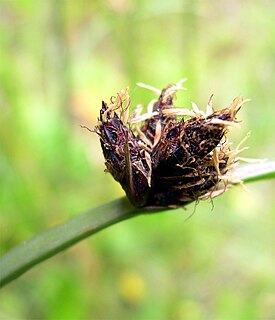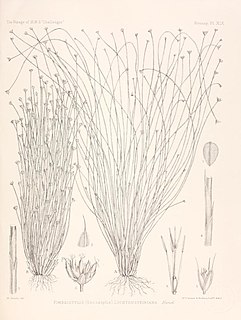
The Cyperaceae are a family of graminoid (grass-like), monocotyledonous flowering plants known as sedges. The family is large, with some 5,500 known species described in about 90 genera, the largest being the "true sedges" genus Carex with over 2,000 species.

Rhynchospora is a genus of about 400 species of sedges with a cosmopolitan distribution. The genus includes both annual and perennial species, mostly with erect 3-sided stems and 3-ranked leaves. The achenes bear a beak-like tubercule and are sometimes subtended by bristles. Many of the species are similar in vegetative appearance, and mature fruits are needed to make a positive identification.
The Catalogue of Life is an online database that provides an index of known species of animals, plants, fungi, and microorganisms. It was created in 2001 as a partnership between the global Species 2000 and the American Integrated Taxonomic Information System. The Catalogue interface is available in twelve languages and is used by research scientists, citizen scientists, educators, and policy makers. The Catalogue is also used by the Biodiversity Heritage Library, the Barcode of Life Data System, Encyclopedia of Life, and the Global Biodiversity Information Facility. The Catalogue currently compiles data from 168 peer-reviewed taxonomic databases that are maintained by specialist institutions around the world. As of June 2021, the Catalogue lists 1,997,284 of the world's 2.2m extant species known to taxonomists on the planet at present time.

Fimbristylis is a genus of sedges. A plant in this genus may be known commonly as a fimbry or fimbristyle. There are 200 to 300 species distributed worldwide. Several continents have native species but many species have been introduced to regions where they are not native. Some are considered weeds. These are typical sedges in appearance, with stiff, ridged stems and cone-shaped terminal panicles of spikelets. They are found in wet environments, and are most diverse in tropical and subtropical regions.

Fimbristylis thermalis is a species of fimbry known by the common name hot springs fimbry. It is native to the southwestern United States and northern Mexico. It has been reported from Baja California, California, Arizona, Nevada, Utah and Coahuila.

Bulbostylis neglecta, neglected tuft sedge locally, is an endemic member of the Cyperaceae of Saint Helena in the South Atlantic.

Bulbostylis capillaris is a species of sedge known by the common names densetuft hairsedge and threadleaf beakseed. It is native to much of North America, South America and the West Indies from Canada to Bolivia.

Schoenoplectus pungens is a species of flowering plant in the sedge family known as common threesquare, common three-square bulrush and sharp club-rush. It is a herbaceous emergent plant that is widespread across much of North and South America as well as Europe, New Zealand and Australia.
Johann Otto Boeckeler was a German apothecary-botanist of Oldenburg. He specialized in the plant family Cyperaceae (sedges), of which, he was the binomial authority of many species.
Jeremy James Bruhl is an Australian botanist. He is an emeritus professor in the School of Environmental and Rural Science at the University of New England and director of the N.C.W. Beadle Herbarium which holds c.110,000 plant specimens.
Rhynchospora longisetis is a species of plant in the family Cyperaceae first described by Robert Brown. No subspecies listed in the Catalogue of Life.
Bulbostylis bathiei is a species of plant in the family Cyperaceae first described by Henri Chermezon. No subspecies listed in the Catalogue of Life.
Bulbostylis fluviatilis is a species of plant in the family Cyperaceae first described by Robert Kral and Gerrit Davidse. No subspecies are listed in the Catalogue of Life.
Bulbostylis eleocharoides is a species of plant in the family Cyperaceae first described by Robert Kral and Mark T. Strong. Its native range is Bolivia to Paraguay. No subspecies are listed in the Catalogue of Life.
Bulbostylis haitiensis is a species of plant in the family Cyperaceae first described by Georg Kükenthal. No subspecies are listed in the Catalogue of Life.
Carex agglomerata is a species of plant in the family Cyperaceae first described by Charles Baron Clarke.
Carex haematorrhyncha is a species of plant in the family Cyperaceae first described by Jisaburo Ohwi and Tetsuo Michael Koyama. No subspecies are listed in the Catalogue of Life.

Abildgaardia ovata is a perennial herb of the genus Abildgaardia and the family Cyperaceae. It is a widespread species that can be found in West, Southern and East Afria, Florida, Mexico, the Caribbean and in some countries of Latin America.

Bulbostylis lichtensteiniana is a species of flowering plant in the sedge family, Cyperaceae, that is endemic to Saint Helena. Unlike other species native to Saint Helena, such as Bulbostylis neglecta, Bulbostylis lichtensteiniana does not show obvious signs of decline due to the spread of invasive plants. However the lack of decline is partially attributed to Bulbostylis lichtensteiniana being the only endemic plant to have expanded into new anthropogenic habitats.
Bulbostylis cangae is a species of flowering plant in the sedge family, Cyperaceae, that is endemic to the Serra dos Carajás in Brazil. It was first identified by Nunes et al. (2016) as part of a joint project with the Museu Paraense Emílio Goeldi and the Instituto Tecnológico Vale which identified 55 species of Cyperaceae in the Carajás National Forest and surrounding areas. The majority of these species were associated with ironstone outcrops, which are known as cangas locally.








